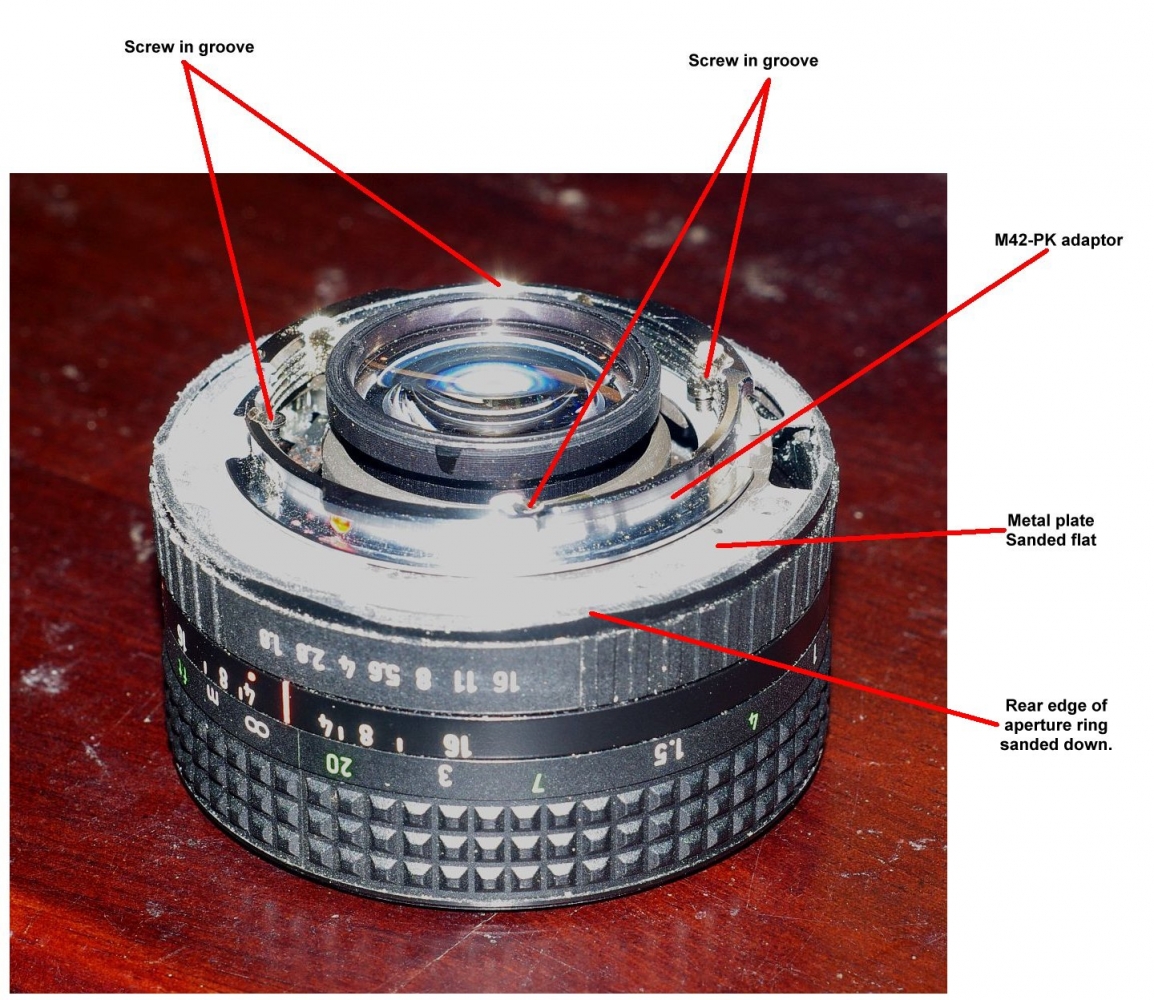| View previous topic :: View next topic |
| Author |
Message |
kypfer

Joined: 27 Sep 2017
Posts: 523
Location: Jersey C.I.
|
 Posted: Sun Dec 31, 2017 3:29 pm Post subject: Pentacon Prakticar 50mm f/1.8 on a Pentax Posted: Sun Dec 31, 2017 3:29 pm Post subject: Pentacon Prakticar 50mm f/1.8 on a Pentax |
 |
|
kypfer wrote:
How to convert the Praktica bayonet-mount Prakticar 50mm f/1.8 for use on a Pentax bayonet camera.
The Pentacon Prakticar 50mm f/1.8 is, apparently, the revered Meyer-Optik Gorlitz "Oreston", re-named after the companies were merged, so well worth a little attention.
#2

Not quite as straightforward as my previous conversion for the Prakticar 50mm f/2.4, nevertheless, with a little effort, this is a fairly easy adaption of a readily available wide-aperture multi-coated lens.
Please note, the lens I worked on is a "late model", with a red-painted index dot, rather than the earlier type with the orange plastic hemispherical reference point. This may or may not be relevant.
To complete this modification and retain infinity focussing you'll need to use one of the original-style M42-PK adaptors, the type without a flange. Remember to remove the locking spring from the adaptor, else once mounted, you'll not be able to remove the lens! If infinity focus is not a criteria for you, one of the flanged type non-infinity-focus adaptors will work as well. If having fitted one, you decide the other would have been a better choice, it's just four screws and a bit of filing to swap the adaptors. Although the adaptors will have been modified, they will still serve in their original role, if required.
First, remove the bayonet mount from the lens, four screws. Don't lose the screws, we'll use them later.
Second, remove the screws retaining the metal plate at the rear of the lens.
Thirdly, lift the aperture operating ring, complete with the metal plate, from the rear of the lens. There is an aperture actuating rod protruding from the metal plate, so lift straight off.
Fourth, being very careful to not lose the aperture click-index ball and spring, extract the metal plate assembly from within the aperture ring.
Disassemble everything off the metal plate. Once we're finished we'll not be able to use the lens on a Praktica camera, so we can lose the electrics, but keep the aperture control rod linkage and it's associated spring in a safe place, for reassembly later. Note that this mechanism is guided in a plastic assembly, we'll need this as well.
Now you should have just the aluminium metal plate, which is the bit that needs modifying.
Basically you need to cut/sand/file all the protrusions off the back of this plate, (the surface adjacent to the camera, where the original bayonet was mounted), to be left with a completely smooth surface. I'll not detail how I butchered mine, it'll only put you off. I'm sure that if you are confident enough to tackle a job like this you'll figure out how to achieve it using the tools and skills available to you.
Once this is achieved, reassemble the aperture control linkage to the plate, don't forget the plastic guide, then fit this assembly back into the aperture control ring, not forgetting the click-index ball and spring (unless you want a "de-clicked" lens, of course).
At this point, you'll notice the aperture control ring protrudes slightly beyond the rear of the metal plate. This needs to be trimmed back so it doesn't foul the camera body when mounted.
The inner diameter of the M42 thread in our new bayonet is slightly too small to allow the use of the four screws we kept aside when we removed the original bayonet, so four grooves will need to be filed, with a little extra relief for the countersunk heads, then the M42-PK adaptor can simply be attached to the rear of the lens using these four screws, job done!
My conversion focusses "slightly beyond" infinity, the super-critical may want to include a few thou of shims to compensate if this is a problem.
If required, a recess to accommodate the lens locking pin could be drilled into the metal plate.
Initial inspection suggests that the Prakticar 135mm f/2.8 could be converted in the same manner, but I've not yet tried.
#1
 |
|
| Back to top |
|
 |
visualopsins


Joined: 05 Mar 2009
Posts: 11044
Location: California
Expire: 2025-04-11
|
 Posted: Sat Jan 06, 2018 2:06 am Post subject: Posted: Sat Jan 06, 2018 2:06 am Post subject: |
 |
|
visualopsins wrote:

Good for reference!
_________________
☮☮☮☮☮☮☮☮☮☮☮☮☮☮☮☮☮☮☮☮☮☮☮☮☮☮☮☮☮☮☮☮ like attracts like! ☮☮☮☮☮☮☮☮☮☮☮☮☮☮☮☮☮☮☮☮☮☮☮☮☮☮☮☮☮☮☮☮
Cameras: Sony ILCE-7RM2, Spotmatics II, F, and ESII, Nikon P4
Lenses:
M42 Asahi Optical Co., Takumar 1:4 f=35mm, 1:2 f=58mm (Sonnar), 1:2.4 f=58mm (Heliar), 1:2.2 f=55mm (Gaussian), 1:2.8 f=105mm (Model I), 1:2.8/105 (Model II), 1:5.6/200, Tele-Takumar 1:5.6/200, 1:6.3/300, Macro-Takumar 1:4/50, Auto-Takumar 1:2.3 f=35, 1:1.8 f=55mm, 1:2.2 f=55mm, Super-TAKUMAR 1:3.5/28 (fat), 1:2/35 (Fat), 1:1.4/50 (8-element), Super-Multi-Coated Fisheye-TAKUMAR 1:4/17, Super-Multi-Coated TAKUMAR 1:4.5/20, 1:3.5/24, 1:3.5/28, 1:2/35, 1:3.5/35, 1:1.8/85, 1:1.9/85 1:2.8/105, 1:3.5/135, 1:2.5/135 (II), 1:4/150, 1:4/200, 1:4/300, 1:4.5/500, Super-Multi-Coated Macro-TAKUMAR 1:4/50, 1:4/100, Super-Multi-Coated Bellows-TAKUMAR 1:4/100, SMC TAKUMAR 1:1.4/50, 1:1.8/55
M42 Carl Zeiss Jena Flektogon 2.4/35
Contax Carl Zeiss Vario-Sonnar T* 28-70mm F3.5-4.5
Pentax K-mount SMC PENTAX-A ZOOM 1:3.5 35~105mm, SMC PENTAX ZOOM 1:4 45~125mm
Nikon Micro-NIKKOR-P-C Auto 1:3.5 f=55mm, NIKKOR-P Auto 105mm f/2.5 Pre-AI (Sonnar), Micro-NIKKOR 105mm 1:4 AI, NIKKOR AI-S 35-135mm f/3,5-4,5
Tamron SP 17mm f/3.5 (51B), Tamron SP 17mm f/3.5 (151B), SP 500mm f/8 (55BB), SP 70-210mm f/3.5 (19AH)
Vivitar 100mm 1:2.8 MC 1:1 Macro Telephoto (Kiron)
|
|
| Back to top |
|
 |
|
|
|
You cannot post new topics in this forum
You cannot reply to topics in this forum
You cannot edit your posts in this forum
You cannot delete your posts in this forum
You cannot vote in polls in this forum
|
